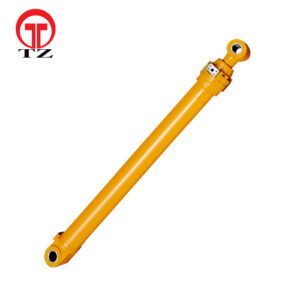Maintenance and inspection procedures for hydraulic cylinders in excavators are crucial to ensure their optimal performance and longevity. Here are some common practices:Regular Visual Inspections: Perform routine visual inspections of the hydraulic cylinders to check for any signs of damage, leaks, or wear. Look for fluid leaks, dents, scratches, or corrosion on the cylinder body and rod. Inspect the seals for any signs of deterioration or leakage.
Fluid Level Check: Monitor the hydraulic fluid level in the excavator's reservoir. Ensure that it is within the recommended range. Low fluid levels can lead to poor cylinder performance and potential damage.
Fluid Analysis: Periodically analyze the hydraulic fluid to assess its condition. Fluid analysis can help identify contaminants, excessive wear particles, or changes in fluid properties that may indicate potential issues with the hydraulic cylinders or system.
Seal Inspection and Replacement: Inspect the cylinder seals regularly for wear or damage. Replace any worn or damaged seals promptly to prevent fluid leaks and maintain proper cylinder performance. Follow the manufacturer's recommendations for seal replacement intervals.
Lubrication: Lubricate the cylinder rod regularly with a recommended lubricant to reduce friction and prevent wear. Ensure that the lubrication points are clean and properly greased.
Cylinder Rod Cleaning: Keep the cylinder rod clean and free from dirt, debris, or other contaminants. Wipe the rod with a clean cloth before retracting it into the cylinder to prevent particles from entering the cylinder and causing damage to the seals or surfaces.
Cylinder Rod Protection: Use appropriate rod boots or covers to protect the cylinder rod from external elements such as dirt, rocks, or debris. These protective covers help minimize the risk of damage to the rod and seals.
Operating Environment: Avoid operating the excavator in extreme conditions or situations where the cylinders may be exposed to excessive heat, cold, moisture, or corrosive substances. Extreme environments can accelerate wear and compromise cylinder performance.
Proper Cylinder Operation: Operate the hydraulic cylinders within their specified load capacities and operating parameters. Avoid overloading the cylinders or subjecting them to sudden shocks or impacts that can cause damage.
Scheduled Maintenance: Follow the manufacturer's recommended maintenance schedule for the hydraulic system, which includes inspections, fluid changes, and other preventive maintenance tasks. Adhering to a regular maintenance routine helps identify and address potential issues before they escalate.
It's important to note that the specific maintenance and inspection procedures may vary depending on the excavator model, manufacturer recommendations, and operating conditions. Consulting the equipment's manual and seeking guidance from qualified technicians or the manufacturer's support can provide more detailed and accurate instructions for maintaining hydraulic cylinders in excavators.
How are hydraulic cylinders in excavators powered and controlled?Hydraulic cylinders in excavators are powered and controlled by hydraulic systems. Here's an overview of how these systems operate:
Power Source: Hydraulic systems in excavators are typically powered by hydraulic pumps. These pumps are driven by the engine of the excavator or by separate hydraulic power units.
hydraulic cylinder excavator The pump pressurizes hydraulic fluid, usually oil, which is then distributed to various components, including the hydraulic cylinders.
Control Valves: Control valves play a crucial role in directing the flow of pressurized hydraulic fluid to the hydraulic cylinders. These valves are operated by the operator through control levers or joysticks in the cabin of the excavator. By manipulating these controls, the operator can adjust the flow and direction of hydraulic fluid, enabling precise control of the hydraulic cylinders.
Hydraulic Lines: Hydraulic fluid flows through a network of hydraulic lines or hoses from the pump to the control valves and then to the hydraulic cylinders. These lines convey the high-pressure fluid, ensuring it reaches the cylinders for actuation.
Hydraulic Cylinders: The hydraulic cylinders themselves are responsible for converting hydraulic pressure into linear motion. Each cylinder consists of a cylindrical barrel, a piston, and a piston rod. The piston divides the cylinder into two chambers: the rod side and the cap side. As pressurized hydraulic fluid enters one chamber, it pushes against the piston, causing the piston rod to extend or retract, depending on the hydraulic flow and control valve position.
Sealing System: Hydraulic cylinders contain seals to prevent fluid leakage and maintain pressure. Common seals include piston seals, rod seals, and wiper seals. These seals ensure the hydraulic fluid remains contained within the cylinder and prevent contaminants from entering.
Feedback Mechanisms: Some excavators may incorporate feedback mechanisms, such as position sensors or load sensors, to provide feedback on the position or force exerted by the hydraulic cylinders. This information can be used for control and monitoring purposes, enhancing the precision and safety of the excavator's operation.
By regulating the flow and pressure of hydraulic fluid through control valves, the operator can control the extension and retraction of the hydraulic cylinders in the excavator. This control allows for various operations, such as lifting, digging, tilting, and rotating the excavator's boom, arm, and bucket.

